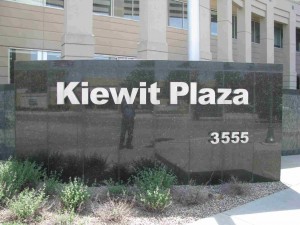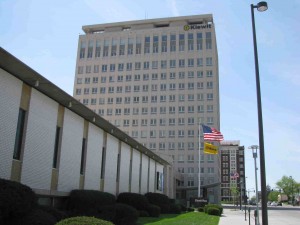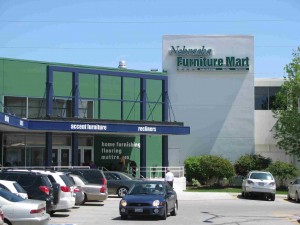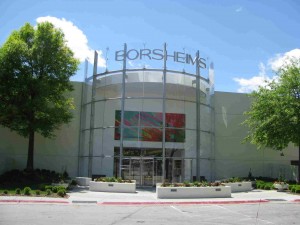NOTE: Every week I write a Client Note for my clients. For a limited time, I am allowing non-clients to sign up and receive the Client Note. You can sign up at the top right hand corner of the website. I will also be posting the notes on my blog with a 24-48 hour delay from time to time. Here is this week’s.
*****
It is 11:30pm Mountain Time, Tuesday night. I am sitting in my hotel room in Cheyenne, Wyoming.
Two Saturdays ago I set out by car for Omaha, NE. My destination: The Qwest Center, Saturday May 1, 8:30am, home to the Berkshire Hathaway annual meeting.
*****
Earlier this year, my father picked up some Berkshire B shares. It was a trade to capitalize on the coming 1 for 50 split of the shares Berkshire had undertaken in order to carry out the purchase of Burlington Northern Santa Fe (formerly BNSF), Buffett’s “all-in wager on the economic future of the United States” as he put it at the time.
Dad reasoned that the split, which would put Berkshire shares in the $60-range, would open up Buffett and Berkshire to a whole range of investors who had previously been unable or unwilling to shell out the $3,000 required to buy just one B share. Because of Buffett’s revered status among American investors, Dad believed the lower price would increase demand for the shares and cause the price to rise.
As a result of the acquisition and stock split, Standard & Poors decided to replace Burlington Northern with Berkshire Hathaway in the S&P 500. Because a tremendous amount of money is invested passively, and most index funds track S&P 500, the inclusion of shares in that index results in many funds having to buy the shares in proportion to their weighting in the index. This increased demand pushes up the stock price of companies added to the S&P 500.
In the end, the trade worked to perfection with Berkshire B shares having traded as high as the low $80s earlier this year and closing yesterday around $78 a share.
*****
A month or so ago, I turned to Buffett to see if his writings and personal history might shed any light on this manic market rally that has been running me over. Sure enough I found what I was looking for in the Go-Go market of the late 1960s. (I first wrote about Buffett during this period in
“Top Gun FP Client Note: The Recession Is Over”, April 11 (send date), 2010).
In his Partner Letters from that period, Buffett repeatedly weighed in on the speculation and excessive valuations he saw all around him. In October 1967, he wrote: “I am out of step with present conditions”.
And in May 1969, despairing of finding suitable investments, Buffett had had enough and called it quits: “I am not attuned to this market environment, and I don’t want to spoil a decent record by trying to play a game I don’t understand just so I can go out a hero.” At the end of 1969, Buffett returned the money he managed, a bit more than $100 million – a considerable amount at the time – to his partners and began to think about his next step.
During the 12 months from May 1969 to May 1970, the Dow dropped about 35%. But even that doesn’t adequately account for the crash. Many of the highflying stocks of the Go-Go era dropped far more than the stodgy Dow; 50%, 60%, even 80% declines were common for these formerly beloved stocks.
In mid-April, I turned to Buffett’s annual Berkshire letters, world renowned letters that played no small part in his rise to fame among investment aficionados, starting with the 2009 edition. Discovering that the 2010 annual meeting was to be held a few weeks hence on Saturday, May 1, 2010, I conceived the idea of attending. I called my Dad to see if he still held the shares, which entitled him to four shareholder passes to the meeting, and found out that he did.
*****
On Saturday morning, April 24, a little before 9am Pacific Time, I set out from my home in Granite Bay, CA for the Qwest Center in Omaha, NE, 1566 miles and more than 22 hours drive away, according to MapQuest. I had reservations for a hotel room in downtown Omaha for the weekend of the annual meeting but besides for that I did not know where I would stay.
During that first day, I drove a little more than two hours to Reno and then across the desert of Nevada, to Elko in Eastern Nevada.
On Sunday, I drove from Elko to Salt Lake City, UT.
The thing that struck me the most was how little development and how much open land there is between Reno and Salt Lake City. Mile after mile for hundreds of miles it is just desert. Here and there are small towns, isolated from the broader society most of us live in. But for the most part there is nothing.
On Monday morning, I headed east from Salt Lake City and the land began to live up to my expectations. I climbed snow capped mountains and then descended into a beautiful valley with great green pastures and a breath taking lake. The land became more varied with hills and jagged cliffs. The scenery was much improved from the barren desert.
I drove across pristine Wyoming (Population: 544,270) texting: “The United States of America is a myth. There is nobody here.”
I got nervous when my gas indicator went on as the temperature descended into the mid-40s in eastern Wyoming. I hadn’t seen any sign of civilization in hundreds of miles. I was rescued by a truck stop west of Laramie, WY. My spirits lifted as I filled my car with gas amid lightly falling snow and mid 30s temperature.
The 80 ascends into Laramie, WY, elevation 7,165, where light snow was falling and the temperature fluttered below 30 on my car thermometer. I hadn’t anticipated this type of weather and night was fast approaching. Fortunately, the 80 descends into Cheyenne, Wyoming’s capital city, where the weather was much nicer (sunny, high 40s).
On Tuesday, I drove across Nebraska where sporadic industrial plants and more systematic agriculture distinguish it from Wyoming. I reached Lincoln as night fell and spent the night there.
On Wednesday around noon, I set out for Omaha. However, as I was leaving the hotel parking lot I heard on the radio that an overturned big rig had shut the 80 just east of Lincoln, blocking the path to Omaha.
As a result, I had to take a detour around the accident which resulted in a happy little coincidence. Running along the 80 for much of the way are train tracks. But the trains running on those tracks are CSX trains. Where, I wondered, was Burlington Northern? As I made my way east along the detour, south of the 80, I caught a glimpse of a big, beautiful orange Burlington Northern locomotive. I took it as a good omen.
Wednesday afternoon, I stopped in Omaha to take a look at Kiewit Plaza, Buffett’s office since 1962 described by his biographer Roger Lowenstein as follows:
Kiewit Plaza was perched at the crest of a hill on the outskirts of Omaha’s business district, in a hybrid neighborhood with strip shopping, apartments, and an old steel foundry. Buffett’s building was drably functional down to the industrial-carpeted halls – happily drab, as Buffett could assure his partners that he wasn’t overspending (Roger Lowenstein, Buffet: The Making Of An American Capitalist (DoubleDay: 1995), pg. 74).
I snapped a couple shots of Kiewit Plaza and the vacant pizza shop across the street. (The photos are attached at the end of the post along with shots of the Nebraska Furniture Mart and Borsheim’s, two large Omaha-based, Berkshire retail holdings).
Wednesday and Thursday night I stayed in Council Bluffs, Iowa, home to the Horseshoe Casino with a poker room where I killed a few hours the two days before the meeting. Council Bluffs is across the state border of Iowa and Nebraska – 5 minutes from Omaha. The highlight was gusting winds, torrential rains, thunder storms and a tornado warning on Thursday night.
On Friday afternoon, I headed over to the Qwest Center to pick up my shareholder credential and then checked into my hotel. My friend Eric Sprague and his brother Joel flew in for the meeting that afternoon and we met for dinner at Piccolo’s steak house – a Buffett favorite – at 7:40pm. We ate a massive meal including salad, baked potato, string beans and a large steak for about $17 each. (On Sunday, we dined at another of Buffett’s favorite restaurants, Gorat’s, where we chatted a bit with the owner, Debbie).
*****
A record 40,000 were expected at the annual meeting this year and the Qwest Center main auditorium only sits 17,000. The rest are put in side rooms with video screens. To get a seat in the main auditorium we knew we’d have to get there early. The Qwest Center opened at 7am Saturday morning and my goal was to be there at 7:30am.
I got there according to plan and was able to secure three good seats in Section 214, a lower upper deck section directly facing the stage and video screens.
The annual meeting kicked off at 8:30am with an hour long montage of short videos related to Buffett, Munger and Berkshire Hathaway. It dragged and I was anxious to get on with the main event: a 5 hour Q&A with Buffett and Munger.
Finally, at 9:30am, Buffett and Munger made their appearance. Buffett introduced Berkshire’s directors, including Bill Gates, and then made a quick review of 1st quarter earnings.
It was probably 9:45am when the Q&A session kicked off. The format was a question from one of three financial journalists (Carol Loomis from Fortune Magazine, Andrew Ross Sorkin from The New York Times and Becky Quick from CNBC) who had each selected questions from among thousands sent to them alternating with a question from a shareholder in the audience whose question had been drawn from a hat that morning.
Longtime Buffett chronicler and friend Carol Loomis kicked off the proceedings with the question everyone was anticipating about the SEC’s suit against Goldman Sachs. Many had sent the question to her, she said, but she wanted to particularly thank Greg Feirman, XXXX, XXXX, XXXX. After I heard my name, I didn’t hear the rest.
It was surreal. 37,000 had travelled here to hear Buffett. Bill Gates was in attendance. So was George Lucas. At the top of the Qwest Center sat a huge row of journalists and other media with their laptops. Big money from across the world was present.
I wondered why Carol Loomis had thanked me first. Obviously my question was not original. It was on everyone’s mind and countless had certainly e-mailed her the same question. But she had selected a few to single out and thank for help in formulating the question the way she did.
Had she read my Client Note on the SEC’s equivocation between a CDO and a synthetic CDO and found it useful? Or was it just a coincidence that I was the first thanked? Was it alphabetical?
I don’t really know. But I will never forget that moment.
*****
Buffett answered the question with a resounding defense of Goldman. ACA was a bond insurer and it had agreed to sell Paulson the CDS on $900 million of MBS for a fee. That was its business. That’s what it did.
It was a completely standard transaction, Buffett said.
In fact, he himself had taken the position of ACA in a similar transaction with Lehman Brothers on the other side a couple years prior. Berkshire agreed to insure an $8.25 billion portfolio of muni bonds entirely picked out by Lehman Brothers for 10 years for $160 million.
In contrast to the Paulson case, it seems as though Buffett knew Lehman had selected the bonds to be insured and was on the other side. Even so, Buffett noted, he agreed to insure the complete set of bonds selected by his counterparty, with full knowledge that they must have had a contrary view of the portfolio to him.
He was trying to illustrate the point that long and short parties are inherent to a transaction of this nature. The fact that a bearish hedge fund was involved in putting together the deal is not some deep, dark secret that amounts to fraud, but a completely standard aspect of a transaction of this kind. ACA and IKB, the sellers of the CDS, knew there was someone buying the CDS and it wasn’t hard to infer that the buyer might be bearish on the mortgage backed securities on which it was buying protection.
*****
The other question I submitted to Carol Loomis was:
In October 2008 you wrote in The New York Times that you were buying US stocks. Would you still buy US stocks today after an 80% rally in the S&P 500?
Throughout his career, Buffett has mostly refrained from commenting on the general level of stock prices. He prefers to focus on individual stocks and not make broad pronouncements about the market as a whole.
But there are a number of notable exceptions in which Buffett has publicly commented on the overall stock market.
The first was in
October 1974 when he told Forbes he felt “Like an oversexed guy in a harem. This is the time to start investing.” “Now is the time to invest and get rich,” Buffett said.
The Dow was then at 580. Within two months, the market bottomed, at the low of the entire 1966-82 secular bear market, and the Dow rallied 75% over the next two years.
The next time Buffett commented on the overall stock market was in a
November 1999 article for Fortune Magazine by Carol Loomis that was an account of a couple of speeches on the subject Buffett had given that July and September and which Buffett reviewed and weighed in on with some clarifications. The message of the article was that the public’s expectations for stocks had gotten too high and the market was poised to deliver disappointing returns going forward. We all know how that turned out.
Most recently, Buffett wrote an op-ed for The New York Times on October 17, 2008:
“Buy American. I Am”.
In the afternoon session of the Q&A, a shareholder asked essentially my question, even referencing the October ’08 New York Times op-ed. Buffett didn’t seem to have the same appetite for stocks now that he had then but he was by no means bearish. He disclaimed that he has no idea what the stock market will do over the short term, but that stocks are likely to outperform cash and bonds over the longer term. This, however, is partly because he is bearish about the outlook for cash and bonds, not because he is extremely bullish on stocks.
SPECIAL OFFER – FREE INVESTMENT REVIEW: For a limited time I am offering a free investment review. Pick any stock, bond, ETF or mutual fund. I will do a comprehensive fundamental/macro/technical analysis, write a concise analyst report, and consult with you for 30 minutes by phone or in person for free.
Greg Feirman
Founder & CEO
A Registered Investment Advisor
9700 Village Center Dr. #50H
Granite Bay CA 95746
(916) 224-0113
CALL NOW FOR A FREE INVESTMENT REVIEW!





